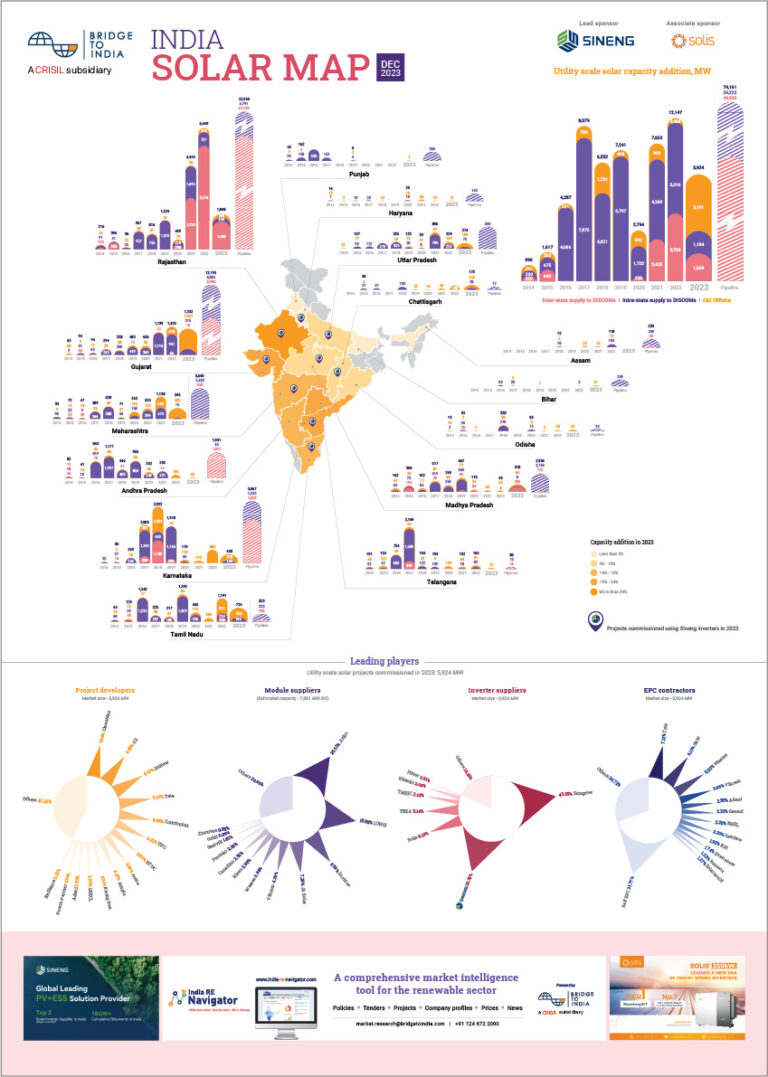India added 2,770 MW of renewable capacity in Q4 2019. For the year 2019, total capacity addition is estimated at 11,403 MW comprising 7,140 MW utility scale solar, 1,896 MW rooftop solar and 2,367 MW wind. The total figure is up marginally over 10,683 MW capacity addition in 2018 but substantially lower than 14,031 MW in 2017.
- Capacity addition numbers are stuck at levels far below government targets;
- Weak demand growth poses a major risk to growth outlook;
- We estimate new capacity addition at 58 GW in the next five years;
Outlook for 2020 is expected to be only marginally better. 14,300 MW of utility scale solar and wind capacity is scheduled to come online in the year but we expect actual addition at around 12,000 MW based on past track record. The slippage could be worse if disruption from Corona virus extends into the second quarter.
There are various reasons cited for slow growth of the sector. Most analysts and industry experts blame delays in land acquisition, lack of transmission connectivity and reluctance of banks to provide debt financing. But the risk which often gets ignored is weak power demand – a tepid 3.8% CAGR over last four years and just over 1% in YTD FY 2020.
Slow demand growth is worsening supply surplus situation as more thermal capacity continues to be commissioned. Excess capacity has already caused severe stress in the power sector with average thermal PLFs falling to record low of 56% during Apr-Dec 2019. More than 40 GW of thermal power capacity is believed to be stranded because of lack of PPAs while DISCOMs remain reluctant to sign long-term PPAs. Meanwhile, banks fearing a hit on their power sector loans are wary of lending to renewable projects.
Figure: Total installed capacity and peak demand, GW

Source: CEA, India Renewables Outlook report by BRIDGE TO INDIA
Note: Peak demand and PLF figures are given for the financial years ending on respective dates.
We have modelled various scenarios for power demand growth (between 3.5-5.0% per annum) and thermal PLFs (53-60%). Accordingly, we estimate total solar and wind capacity addition of only 43 GW and 15 GW respectively by 2024, far below the government aspirations.
Figure: Projected solar and wind capacity, GW

Source: India Renewables Outlook report by BRIDGE TO INDIA
Unfortunately, there is not much insight into reasons for power demand slowdown. Even the link with GDP is tenuous as per the Economic Survey. The outlook could yet get worse if industrial activity doesn’t pick up or T&D system losses are reduced as per recent Ministry of Power initiatives.
DISCOMs want firm and cheap power, both areas in which coal still decisively trumps renewables despite advancements in storage technologies. Unless demand picks up substantially, the DISCOMs would continue to go slow on renewable power procurement and we would see continued instances of tender cancellations and tariff negotiation.
Note: Please read our new report INDIA RENEWABLES OUTLOOK for more insight into 5-year trajectory for the sector including prospects for key sub-markets (storage, rooftop solar, open access, and module manufacturing).












